Vintage W. Watson & Sons Edinburgh-H No. 2 Metallurgical Microscope c1937, Cased

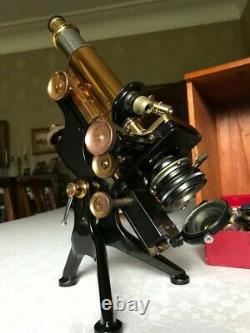
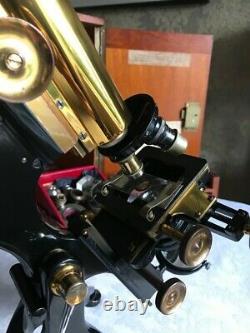
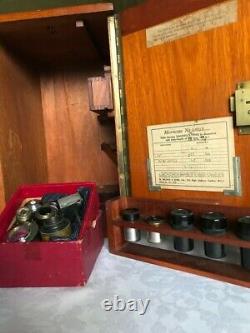
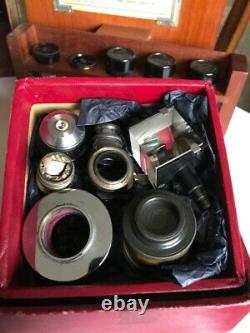
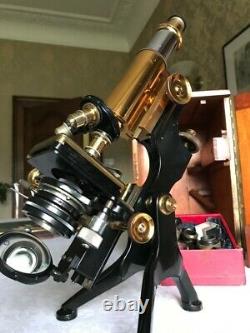
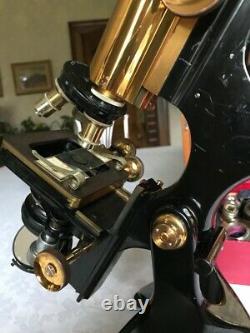
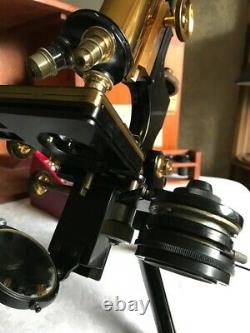
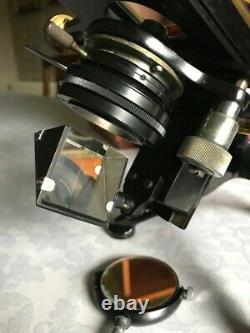
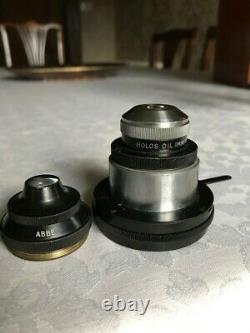
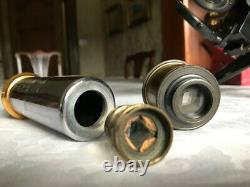
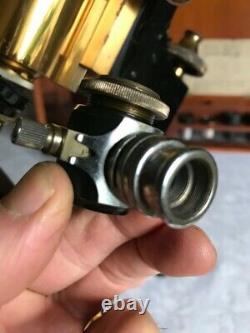

This listing is for a very interesting late example of Watson's Edinburgh Stand-H model microscope in brass - it actually dates to 1937 (which was Watson's centenary year), based on its serial number of 62956, which is confirmed because the original Watson guarantee card is also present on the inside of the case door. The Edinburgh-H model was produced by W. Watson & Sons Ltd between 1887 and around 1945; its long production run giving us a firm clue regarding just how good this model of microscope was in its heyday and over that long production cycle Watson regularly updated and improved the model, so what you see here is a late model with many such upgrades and modifications essentially baked-in. The Edinburgh stand was originally developed by Watson in collaboration with a professor and lecturer in bacteriology at the University of Edinburgh, hence the Edinburgh designation. With its signature rear cross-member giving that classic "H" look, nice brass-work and shiny black paintwork, the Edinburgh H is a fine example of British optical engineering with a design and style essentially dating back to the Victorian era. This example is in the rare metallurgical configuration and the rear cross-member has the designation No. 2 Metl which is short for metallurgical and when the instrument is used in this configuration allows opaque samples to be viewed using incident illumination.
This example also has a sub-stage mirror and condenser thereby allowing standard transmitted light/brightfield capability, as well as polarising capabilities - all these functions are detailed later in the listing. This instrument is just as capable for transmitted light applications as it is with incident light, even more so than a standard Edinburgh-H model, because you can alter the stage height to achieve focus, meaning therefore that you can also use very long working distance objective lenses without having to rack the coarse focus right up to the top of its range.
In terms of the technical details, the coarse focus is via rack and pinion, with fine focus achieved via a separate brass thumb-wheel located at the rear of the upper frame which operates an internal vernier screw/lever system. The focusing technique being to achieve near focus with the coarse thumb-wheels, then fine-tune with the single rear thumb-wheel, which only has a fairly small range of movement. With the optics, this Watson microscope comes fitted with a period graduated chromed eyepiece draw-tube inside a brass main optical tube and three quality vintage eyepieces that with adequate illumination produce very good images: - 6x magnification - No. 2 with integral draw-tube and internal micrometer graticule with 0 to 100 vertical linear scale. 20x magnification - Watson Holos with integral draw-tube. 1/2 inch Parachromatic in brass - Watson - 20 x magnification. 1/6th inch Parachromatic for metallurgy in brass - Watson - approx. (The Watson objectives all have their correct Bakelite canisters). Overall therefore, the range of magnification available with this Watson ranges from about 30x with the lowest power lens combination, up to a maximum of around 400x for brightfield and a theoretical 800x when using the 20x Holos eyepiece with the 1/6th inch metallurgical objective lens. There's also a vertical illuminator (shown in the final listing photo) with internal rotating half-silvered mirror, which can be fitted instead of the triple turret. When in use, the vertical illuminator can be used to direct light from a source such as a microscope lamp down through the objective lens and onto an opaque sample. The light is then reflected back up through the objective lens and into the eyepiece. Specialist metallurgical objective lenses are usually required for medium/high power incident light techniques and there is one metallurgical lens supplied with the instrument - the 1/6th inch Watson Parachroamtic for metallurgy. Turning to the stage, the fully mechanical stage is an original Watson item in brass with twin x/y thumb-wheels on the right hand side of the stage, together with the addition of a couple of period specimen clips for holding slides steady during inclined viewing and when the axes are being moved around.The freely running x/y controls also offering good control of specimen positioning, which is a real advantage for higher magnification work. With this being a metallurgical model the stage height can be raised or lowered using a rack and pinion system with twin-sided brass thumb-wheels - this is to allow opaque samples of different thicknesses to be accommodated on the stage and studied using the incident illumination hardware. With the sub-stage, we also have brightfield hardware being a Watson abbe-type condenser, which sits in a height adjustable helical screw mount with thumb-wheel to adjust the height and also this gives swing-out capability making it easy to swap the condenser lens for a different type.
There's also a Watson Holos oil immersion condenser lens supplied which can be fitted to the condenser body as an alternative - this specialist condenser lens requires oiling to the rear of a slide during use. The condenser also has a working iris to control lighting levels and there's also a polarising filter fitted to the condenser. The supplied polarising hardware also includes an analyser with nicol prism which can be fitted to the bottom of the eyepiece draw-tube giving the instrument polarising capability - there's also a proper nicol prism sub-stage polariser that can be used instead of the polarising filter in the condenser. The polarising hardware thereby allowing thin-section mineral samples and the like to be examined under polarised light conditions. Sub-stage lighting is via a plano-concave mirror on an adjustable gimbal, with period silvering that's in very good condition to both sides and there's also a prism that can be used for illumination purposes instead of the mirror. All the instrument's controls have been lubricated and operate nice and smoothly including coarse focus, fine-focus, eyepiece draw-tube, mechanical stage, condenser and plano-concave mirror. This instrument presents really well with gleaming brass-work showing some signs of tarnishing and spotting here and there mainly to the thumb-wheels which is what you'd expect for an instrument of this age, but overall it's in pretty good shape as I hope the listing photos demonstrate. This example is essentially a versatile and therefore highly collectible Watson Edinburgh Stand-H model especially with its flexible incident, transmitted and polarised light capabilities; it's in good condition and it'll make a great usable and display item in a home office, library or similar setting. I've got it set up in brightfield mode and it's just as capable as a standard Edinburgh-H model, probably even more so with its useful extra functions and height-adjustable stage. There's also an original hardwood Watson wooden storage case with this example, which is also in reasonably good condition with internal lens rack, sundries container, metal carry-handle and a working lock with that all-important key.There's a few shrinkage cracks here and there to the rear of the case, but on the whole the case presents rather well with a nice surface patina and period sheen. Thanks for looking - please also check out my other listings. Watson & Sons Edinburgh-H No. 2 Metallurgical Microscope c1937, Cased" is in sale since Friday, December 3, 2021. This item is in the category "Antiques\Science/Medicine\Scientific Instruments".
The seller is "arcboutant" and is located in Glasgow. This item can be shipped to United Kingdom, Austria, Belgium, Bulgaria, Croatia, Cyprus, Czech republic, Denmark, Estonia, Finland, France, Germany, Greece, Hungary, Ireland, Italy, Latvia, Lithuania, Luxembourg, Malta, Netherlands, Poland, Portugal, Romania, Slovakia, Slovenia, Spain, Sweden, Australia, United States, Bahrain, Canada, Brazil, Japan, New Zealand, China, Israel, Hong Kong, Norway, Indonesia, Malaysia, Mexico, Singapore, South Korea, Switzerland, Taiwan, Thailand, Bangladesh, Bermuda, Bolivia, Barbados, Brunei darussalam, Cayman islands, Ecuador, Egypt, Guernsey, Gibraltar, Guadeloupe, French guiana, Iceland, Jersey, Jordan, Cambodia, Liechtenstein, Sri lanka, Macao, Monaco, Maldives, Martinique, Nicaragua, Oman, Pakistan, Peru, Paraguay, Reunion, Saudi arabia, South africa, United arab emirates, Ukraine, Chile, Bahamas, Colombia, Costa rica, Guatemala, Honduras, Jamaica, Kuwait, Panama, Philippines, Qatar, Trinidad and tobago, Uruguay, Viet nam, Russian federation.- Period: 1901 to 1950
- Antique: Yes
- Material: Brass
- Type: Microscope

